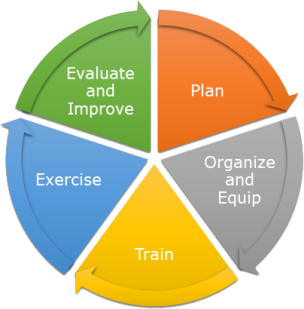Planning Resources
 The Center for Health Emergency Preparedness and Response provides public health leadership to improve health and well-being in Texas. This is accomplished by promoting health, preventing disease and injury, protecting, and effectively responding to all types of health emergencies, including bioterrorism, infectious disease outbreaks, and natural disasters. The Center for Health Emergency Preparedness and Response does this through networking, coordinating, standardizing, and centralizing our resources and planning efforts across the state. Planning is the first of the five steps in the preparedness cycle and is a critical component in community readiness.
The Center for Health Emergency Preparedness and Response provides public health leadership to improve health and well-being in Texas. This is accomplished by promoting health, preventing disease and injury, protecting, and effectively responding to all types of health emergencies, including bioterrorism, infectious disease outbreaks, and natural disasters. The Center for Health Emergency Preparedness and Response does this through networking, coordinating, standardizing, and centralizing our resources and planning efforts across the state. Planning is the first of the five steps in the preparedness cycle and is a critical component in community readiness.
State (ESF-8) Emergency Management Plans
The State's role in disaster response is to maintain overall situational awareness and support community response, to provide guidance to local jurisdictions, and to coordinate securing and deploying state and federal resources, if available, when local assets are insufficient to meet the need. The Department of State Health Services (DSHS) serves as the primary agency for Emergency Support Function 8: Public Health and Medical Services; and is responsible for coordinating the public health and medical response during emergency situations.
For more information on other state plans and annexes, please visit the Texas Division of Emergency Management’s website.
For information on Functional Needs Support Services visit TDEM Training Division Learning Management System website.
Operational & Tactical Plans
DSHS maintains a preparedness and response structure that supports both operational and tactical planning. DSHS operational plans, or “annexes”, are agency-level documents that describe which divisions and programs within DSHS will carry out the roles and responsibilities assigned to DSHS in the State of Texas Emergency Management Plan. DSHS tactical plans, or “standard operating guides (SOGs) and standard operating procedures (SOPs)” describe how DSHS accomplishes those roles and responsibilities.
Operational Plans
Basic Plan (under development)
Annexes:
Tactical Plans
Standard Operating Guides (SOGs):
Planning Toolkits and Technical Guidance
DSHS has developed several toolkits and other technical guidance documents that are targeted at assisting preparedness and response staff at state and local agencies in planning for responding to public health and medical disasters.
Toolkits
Technical Guides
Other Planning Resources
A support and response plan for mosquito-borne diseases in the U.S.-Mexico Border Region of Texas.
Requesting Planning Assistance DSHS
Planning assistance can be requested by contacting the DSHS Public Health Region that services your jurisdiction.
For additional planning related information or questions please email: PreparednessPlanning@dshs.texas.gov.